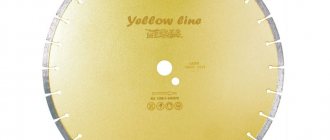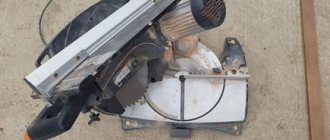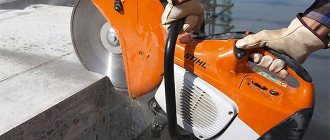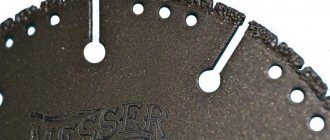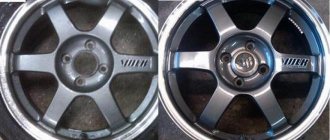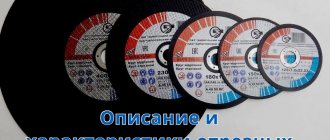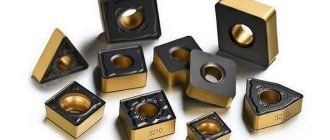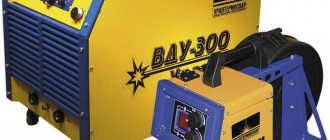Changed and forgot | 04/15/2016
I bet that most of you don’t even know about the existence of these discs, and even if you go to a construction tool store and ask the sales consultants about them, many (not all of course) will look at you with bewilderment. This is understandable; we always associate cutting metal with a grinder or a gas cutter. Well, at worst, with a diamond blade cutting reinforced concrete. And no way, with a disk that looks like the one on a circular saw.
Thickness
Varies between 0.7-4 mm. The choice depends on the diameter of the circle itself and the operations performed. It should be borne in mind that cutting with a thin circle due to the smaller contact area requires less effort and is faster, but the work requires care: if the nozzle is skewed, it may burst. Thickness has virtually no effect on the degree of wear.
In the technical description, the dimensions of the disk, mounting hole and thickness can be indicated both in the metric system and in inches.
Meet me! Carbide blades for metal cutting
The components of all carbide discs are the base and cutting teeth. The number of cutting segments ranges from 24 to 100; the greater the number of teeth, the faster the workpiece is cut. A distinctive feature of the segments is the presence of special solders, which play the main role in cutting. Alloys of cutting teeth can be different, it mainly depends on the manufacturer. In most cases, tungsten-cobalt alloys or tungsten carbide cemented with cobalt are used. Carbide cutting segments are secured by soldering with electrolytic copper solders with the addition of nickel alloys. On many wheel models, you can see slots made to dissipate heat, which extends the life of the carbide wheel.
Such discs are used on pendulum, miter and hand-held circular saws for metal. Of course, there are friction saw blades, which can also be classified as carbide, but this will be the topic of a separate article. Speaking about the distinctive characteristics of carbide discs for metal, each type of metal has its own disc. There are discs for aluminum, discs for high-carbon steel, for low-carbon steel, for thin sheet metal, for sandwich panels, for stainless steel. The most important criteria when choosing are: the diameter of the disk and the diameter of the mounting hole. The most popular diameters are from 200 to 355 mm, the most important thing here is what tool you need the disc for. The same applies to mounting holes, their range is from 20mm. (for hand-held circular saws) up to 30 mm. (for pendulum saws). The number of teeth on the disk is directly proportional to the speed of cutting the material; you should know this when choosing.
You should always check the required number of revolutions, which is indicated on the packaging or on the body of the disk with the passport data of the tool used.
Abrasive material
Wheels for cutting metal are made of silicon carbide (marked with the letter C) and electrocorundum (A). Silicon carbide is a harder material, but inferior to electrocorundum in strength, which is why its use for metal cutting is limited. In addition to the letter designation, the marking contains a number. The larger it is, the higher the quality of the abrasive. Silicon carbide grades: from 52С to 55С – black, 62С-64С – green. Grades of electrocorundum: from 12A to 16A - normal, 22A-25A - white, 32A-35A - chromium, 37A - titanium, 38A (ZA) - zirconium. The cutting ability of zirconium electrocorundum is 10 times higher than normal.
Types of cutting discs for metal
The technical characteristics of cutting wheels (or otherwise disks) for working on metal are regulated by GOST R 57978-2017, which provides for two types of this tool: flat (ISO 41) and with a recessed center (ISO 42). The same GOST establishes size ranges and other standardized parameters for both types. Structurally, a metal cutting disc is a sandwich-type structure consisting of alternating layers of reinforcing mesh and cutting composite into which a metal sleeve is pressed (see figure below).
Reinforcing meshes are usually made of fiberglass and, depending on the conditions of use of the tool, can have different thicknesses and cell sizes. The cutting composite consists of abrasive powder and a binder. For cutting metals, powders from various types of electrocorundum and silicon carbide are used as an abrasive, and bakelite resins are usually used as a binder (although GOST also provides for the use of vulcanites).
The structural and physical properties of cutting discs depend on the type of metal being processed. On this basis, international standards provide for four types of tools: for work on structural steel, cast iron, stainless steel and non-ferrous metals. The latter have many variations in hardness, brittleness and toughness, so manufacturers often indicate in their catalogs what specific type of metal a particular type of disk is intended for. In addition, there are cutting tools for manual and machine work, in particular, metal discs intended for grinders must contain the code “Рд” in the marking.
In addition to reinforced abrasive wheels with resin bonds, there are carbide discs for cutting metal on stationary pendulum and miter saws. Such a tool is usually used in the procurement shops of metalworking enterprises; it has a highly specialized application and belongs to circular saws. Another type of cutting tool is diamond discs, but in accordance with GOST 32833-2014 they cannot be used for cutting metals. Sometimes saw blades used in woodworking on circular machines are also classified as cutting blades. Outwardly, they are somewhat similar to cutting wheels for wood processing. But in fact, such saw blades have a different purpose, and are classified by GOST as “circular saws”.
Binding material
The cutting material is reinforced with vulcanite (consisting of sulfur-rubber mass) or bakelite (containing phenol-formaldehyde resins). Vulcanite is a more elastic material, but the speed of the tool is limited to 50-80 m/s.
Bakelite loses strength at a temperature of 200 °C; heating above 300 °C leads to burnout (hence sparking). However, due to its higher speed, Bakelite is more often used in circles intended for cutting metal. The use of this binder material is indicated by the marking BU or BF.
Pros and cons of carbide wheels for metal
I would like to immediately note that carbide discs have quite a lot of advantages over abrasive discs, but the price of the equipment and the discs themselves hinders the popularity of their use. Let's get everything straight!
The advantages include:
- Cutting accuracy. In order to maintain precision when cutting metal workpieces, a carbide blade on a pendulum saw is one of the best options for working.
- Speed of work. You will be surprised at how fast a carbide blade cuts.
- Huge disk resource. On average, the disk life is 5000 cuts. Compared to abrasive, it is immortal.
- No harmful emissions. When working with abrasives, a cloud of small particles is formed in the work area, which negatively affects human health.
- The metal does not heat up. After you cut the workpiece, you can safely handle it; it will be cold. The main advantage is that the properties of the metal do not change without exposure to temperature.
There are also disadvantages:
- Price. The cost of a carbide disc is tens of times more than an abrasive one. At home, with rare use, such a disk will not pay for itself.
- Loss of metal. Since the disc is thicker than an abrasive one, it is worth considering that the cutting line will be thick.
- Afraid of rust. If you decide to saw metal with rust, remember that this will wear out the disc faster.
Concluding all of the above, we can say that carbide wheels are more professional consumables. They have fewer disadvantages than their competitors, but the price makes them inaccessible for home use.
Diamond blade manufacturers
The following companies are deservedly popular among manufacturers:
- Bosch. German leader in the production of power tools and related materials.
- FIT. The Canadian company produces tools for professional and household use.
- Dremel American company producing high quality power tools.
- Husqvarna. A Swiss company that is known for its high performance and level of durability.
- MESSER. A Korean manufacturer that produces a wide range of attachments for grinders.
- Zubr. Russian company producing power tools and cutting equipment.
- Hitachi Power Tools, Luga Abrasiv Extra. Has excellent value for money.
Diamond cutting discs are an effective tool with high productivity and provide comfortable conditions when performing work. Do you have experience working with them? Be sure to share it in the comments to this article.
Main advantages and disadvantages
Diamond cutting discs are a universal tool. They are suitable for cutting not only metal, but also other materials of increased hardness: brick, reinforced concrete, foam concrete and others. The advantages of this tool include:
- increased geometric cutting accuracy;
- flat surface;
- almost silent operation.
The diamond blade does not exert pressure on structures adjacent to the cutting surface and does not change the structure of the material during operation. At the same time, significantly less time is spent on completing the work than when using other tools. The diamond wheel operates in the absence of a flow of sparks, and, as a result, there is no burning smell.
The cost of work using diamond blades should be calculated for each specific job.
The disadvantages of such a device include its high cost, but the working life of a diamond cutting tool significantly exceeds (almost 70 times) the working life of abrasive discs performing the same work. Equipment downtime is reduced by reducing the frequency of tool replacement. When using active cooling, it is possible to increase rotation speed and productivity. Throughout its service life, the tool retains its geometric characteristics.
Types of diamond blades for metal
Diamond blades vary in purpose, design, and manufacturing technology.
- If they are a round steel plate with a strip of diamond grains applied to its outer edge, they are called solid.
- If they have slots from the edge to the center for approximately 10–15% of the diameter, necessary for heat dissipation, they are called segmented. They can operate at high speeds.
- If an oblique notch is applied to the surface, then this is a turbo. They are more durable.
- A diamond cutting disc with slots and serrations is the most productive and is called turbo-segmented.
The marginal strip of grains is called the cutting edge. Diamond grains come in different sizes and are attached to metal in different ways. The size of diamonds determines work efficiency and working life. Large grains wash the metal being processed better, but wear out more quickly. Small ones work more accurately on metal, but their productivity is lower. But they have a higher working resource.
Diamond grains are attached to a steel plate in various ways: soldering, laser welding, and electroplating. The purpose of the tool also depends on the method of fastening. Discs with soldered grains are used in conjunction with water cooling. Galvanically bonded grains work well with soft materials. Diamond blades with welded grains are good for cutting hard metal alloys.
Diamonds are fixed in the working rim in a certain order. There are disks with a uniform distribution, when segments of the same length contain the same number of crystals.
But there are products in which diamonds are placed at a certain frequency (sandwich). They have greater productivity, exert less pressure on the tool, are better cooled and distribute forces more evenly.
Popular manufacturers and high cost of discs
Prices for consumables for grinders vary from the lowest - about 20 rubles, to several thousand rubles. The high cost directly depends on the manufacturer and what material will be used. The current market is rich in choice of manufacturers, both domestic and foreign.
Bosch
German company, a leader in the production of power tools and related materials. A wide variety of attachments for grinders: diamond and abrasive cutting wheels for stone, metal and wood. The company's products comply with ISO.
Characteristics of Bosch circles on the front of the disc
FIT
Canadian manufacturer of tools for professional and household use. The range includes a wide selection of cutting discs for metal and stone.
Dremel
American company. Produces high quality power tools. There is also a wide selection of attachments for grinders:
- cutting wheels for metal, wood and plastic;
- with diamond coating on concrete, marble, ceramics and porcelain.
Husqvarna
A Swiss company known for its high performance and durability of products. We offer a wide selection of cutting diamond and abrasive discs. The negative point is the high price.
MESSER
Korean manufacturer. A wide range of attachments for grinders:
- carbide wheels for high carbon steel;
- segmented diamond for concrete and asphalt;
- discs for cutting ceramic products, porcelain stoneware and marble.
Zubr
Russian company. Manufactures power tools and cutting equipment. Wide selection of universal attachments for grinders.
Hitachi Power Tools, Luga Abrasiv Extra
. Excellent price-quality ratio. In the assortment you can find budget options, which does not affect the quality of the products.


